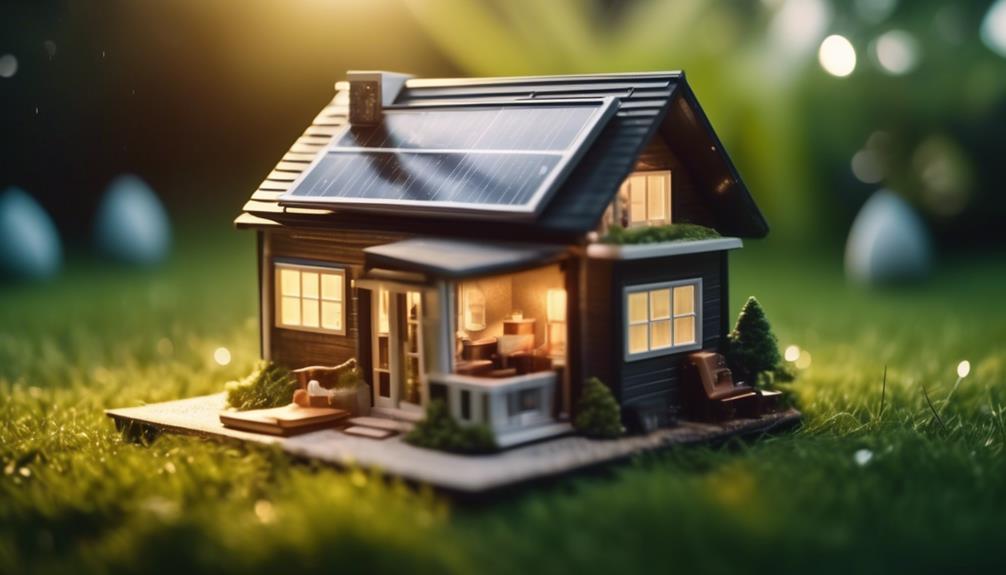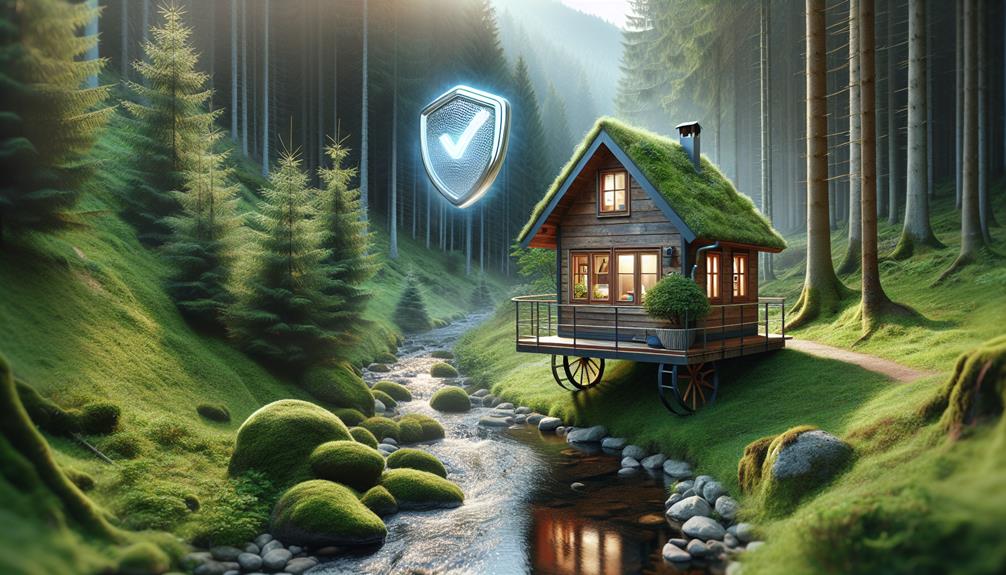Have you ever considered the complexities of insuring a tiny home? As you navigate the exciting journey toward sustainable and minimalist living, it's crucial to understand that, while your home may be small, the need for proper insurance coverage is anything but.
In your quest to safeguard your investment, you'll encounter various insurance types that cater specifically to the unique nature of tiny homes. Whether your dwelling is stationary or mobile, the risks of fire, theft, and natural disasters don't discriminate based on size.
You're about to embark on a path that not only secures your tiny haven but also ensures that you're prepared for the unexpected. Stay tuned as we explore the intricacies of tiny home insurance and unravel the essential knowledge that will arm you with the confidence to make informed decisions about protecting your tiny abode.
Key Takeaways
- Tiny homes may require specialized insurance policies that cover the structure, personal property, and liability.
- Depending on the type of tiny home, RV policies or tailored insurance policies may be necessary for adequate coverage.
- Factors such as the value of the tiny home, location, and usage can impact insurance costs.
- When choosing an insurance policy, consider the necessary coverage, transit endorsement for mobile tiny homes, reputation of insurance providers, and any specific requirements for NOAH-certified or DIY-built tiny homes.
Understanding Tiny Home Insurance
Navigating the ins and outs of tiny home insurance ensures your miniature abode and possessions are well-protected, whether stationary or on the move.
To insure your tiny house effectively, it's essential to understand the coverage you need. Tiny House Insurance encompasses protection for the structure, personal property coverage, and liability. If your home is mobile, you might qualify for RV insurance through the Recreational Vehicle Industry Association, but remember, standard homeowners' policies may not suffice for tiny homes.
Should you own a NOAH-certified builder's creation, specific property insurance policies are available. Moreover, for those of you with designer attire or consignment pieces, consider special insurance policies. And if you're a landlord, landlord insurance is paramount to safeguard your investment.
Types of Tiny Home Coverage
Understanding the various types of coverage available for your tiny home is crucial to ensure you're adequately protected against potential risks and damages. If you own a tiny house on wheels, RV policies may be the right fit to insure your tiny home while on the move. Traditional home insurance for tiny houses may not suffice, as these unique dwellings often need additional, specialized coverage options.
For stationary tiny homes, a tailored insurance policy is essential. Meanwhile, if you rent out your space, landlord insurance becomes necessary. Don't forget to consider specialty insurance for high-value items, such as designer clothes or consignment pieces.
Insurance Cost Factors

When insuring your tiny home, factors such as the construction type, location, and chosen security measures play pivotal roles in determining your insurance premiums. Here are key elements that impact your tiny house insurance cost:
- Type of Tiny Home: Whether it's a stationary, manufactured, mobile, or RV-type tiny home, insurance carriers will adjust the coverage limits and premiums accordingly.
- Location Risks: Areas prone to natural disasters may see higher insurance coverage costs, factoring in the need for additional protection like flood or earthquake insurance.
- Value and Personal Belongings: The overall value of your tiny home, including personal belongings, dictates the insurance policy's dwelling coverage and premiums.
- Usage and Security: Insurance typically per year can fluctuate based on how you use your tiny home and the security measures you've installed.
Understanding these factors can lead to a more tailored and potentially cost-effective Homeowners Insurance for Tiny houses.
Choosing the Right Policy
Having considered the factors that affect your insurance costs, it's crucial to focus on selecting the right policy that aligns with your tiny home's specific needs. Assess the coverage necessary for your dwelling, from the structure itself to your possessions and personal liability. If your lifestyle involves tiny homes on wheels, ensure the insurance policy includes a transit endorsement should you decide to move your tiny home.
When comparing different insurance options, pay special attention to the reputation and rates of the providers. Read the fine print to grasp any exclusions, conditions, and potential discounts thoroughly. For DIY tiny homes, check if being NOAH-certified influences your coverage options.
Lastly, remember that living full time in your tiny house may necessitate a different insurance approach compared to a part-time residence.
Navigating Insurance Challenges

As you delve into insuring your DIY-built tiny home, you'll encounter unique challenges that require careful navigation to secure the right coverage. The insurance landscape for tiny houses can be complex, but understanding the options will help you make informed decisions. Here's what you need to know:
- Type of Tiny Home Insurance: You may not qualify for a standard home insurance policy, so explore specialty tiny house insurance challenges.
- Documentation: Ensure you have thorough documentation, as it's crucial for insurance companies that insure tiny houses.
- Builder Certification: Using a NOAH-certified builder can ease the process, as it may affect liability claims coverage.
- Coverage Options: Consider mobile home insurance, personal property coverage, living expenses coverage, and collision coverage, tailoring your policy to your specific needs.
Frequently Asked Questions
Is It Hard to Insure a Tiny Home?
Yes, insuring your tiny home can be challenging due to unique requirements, size constraints, and policy differences. You'll need custom policies considering risk assessment, mobile protection, and affordability factors for optimal coverage options.
Who Writes Tiny Home Insurance?
Navigating the maze of tiny home insurance, specialty insurers craft policies tailored to your unique needs. They offer mobile protection, consider location factors, and balance premium costs with liability and personal property coverage limits.
Is It Hard to Get Approved for a Tiny Home?
Getting approved for a tiny home can be tricky due to zoning challenges, strict building codes, and varying financing options that reflect your custom design, minimalist living goals, and the need for utility connections.
Does a Tiny Home Add Value to Property?
You're riding the tiny house trend wave! A custom-built tiny home can enhance your property's resale value, thanks to its market appeal, space efficiency, and alignment with minimalist, sustainable living. But watch for zoning challenges.
Conclusion
Securing the right insurance for your tiny home is like fitting a key into a lock—it must be the perfect match for full protection. Consider value, location, and build quality as you weigh your options.
Choose wisely, ensuring coverage for disasters, theft, and liability. Don't hesitate to seek advice from fellow tiny homeowners and experts.
With a tailored policy in hand, you'll rest easy, knowing your tiny sanctuary stands safeguarded against life's unpredictabilities.

